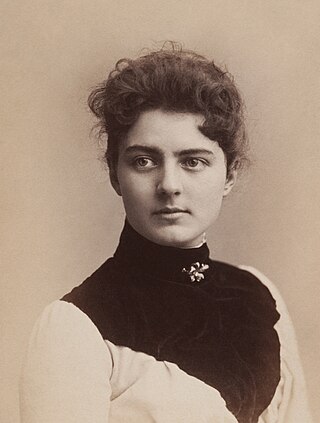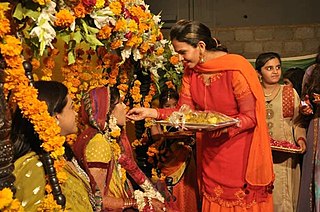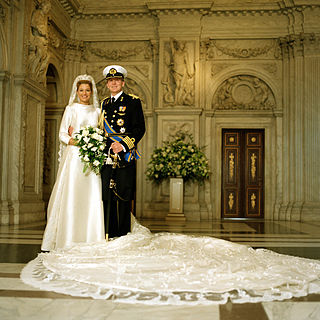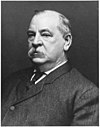A white wedding is a traditional formal or semi-formal wedding originating in Great Britain.

A wedding reception is a party usually held after the completion of a marriage ceremony as hospitality for those who have attended the wedding, hence the name reception: the couple receive society, in the form of family and friends, for the first time as a married couple. Hosts provide their choice of food and drink, although a wedding cake is popular.

Frances Clara Cleveland Preston was the First Lady of the United States from 1886 to 1889 and again from 1893 until 1897, as the wife of President Grover Cleveland. She is the sole first lady in U.S. history to have served in the role during two non-consecutive terms.

A wedding dress or bridal gown is the dress worn by the bride during a wedding ceremony. The color, style and ceremonial importance of the gown can depend on the religion and culture of the wedding participants. In Western cultures and Anglo-Saxon cultural spheres, the wedding dress is most commonly white, a fashion made popular by Queen Victoria when she married in 1840. In Eastern cultures, brides often choose red to symbolize auspiciousness.

The wedding of Prince Charles and Camilla Parker Bowles took place in a civil ceremony at Windsor Guildhall, on 9 April 2005. The ceremony, conducted in the presence of the couple's families, was followed by a Church of England Service of Prayer and Dedication at St George's Chapel. The groom's parents, Queen Elizabeth II and Prince Philip, Duke of Edinburgh, did not attend the civil wedding ceremony, but were present at the Service of Prayer and Dedication and held a reception for the couple in Windsor Castle afterwards.

Rose Elizabeth "Libby" Cleveland served as first lady of the United States from 1885 to 1886, during the first term of her brother, President Grover Cleveland's two administrations. The president was a bachelor until he married Frances Folsom on June 2, 1886, fourteen months into his first term.

The traditional Vietnamese wedding is one of the most important ceremonies in Vietnamese culture, which is influenced by Confucian and Buddhist ideologies.

Marriage in Pakistan pertains to wedding traditions established and adhered by Pakistani men and women. Despite their local and regional variations, marriages in Pakistan generally follow Islamic marital jurisprudence. Marriages are not only seen as a union between a husband and a wife, but also an alliance between their respective families. These traditions extend to other countries around in the world where Overseas Pakistani communities exist.

Punjabi wedding traditions are a strong reflection of Punjabi culture with ritual, song, dance, food, and dress that have evolved over centuries.
A flower girl is a young female who scatters flower petals down the aisle during a wedding procession.

The wedding of Princess Elizabeth and Philip Mountbatten took place on Thursday 20 November 1947 at Westminster Abbey in London, United Kingdom. The bride was the elder daughter of King George VI and Queen Elizabeth as well as the heir presumptive to the British throne. The groom was born a Greek and Danish prince; he stopped using these foreign titles on his adoption of British nationality four months before the announcement of their marriage and was made Duke of Edinburgh, Earl of Merioneth and Baron Greenwich on the morning of the wedding.

The Azerbaijani wedding tradition is one of the most significant and solemn family traditions of Azerbaijani people. It is multi-stepped, and is related to various compulsory rituals and traditions. Ancient Azerbaijani weddings reflect cycles of traditions, lasting for a long period of time, and need significant material costs.

The wedding of Queen Victoria of the United Kingdom and Prince Albert of Saxe-Coburg and Gotha took place on 10 February 1840 at Chapel Royal, St. James's Palace, in London.
The wedding of Princess Eugenie of York and Jack Brooksbank took place on 12 October 2018 at St George's Chapel at Windsor Castle in the United Kingdom. The bride is a member of the British royal family. The groom is a British wine merchant, brand ambassador of Casamigos Tequila, and socialite. The dean of Windsor, David Conner, officiated at the wedding using the standard Anglican church service for Holy Matrimony published in Common Worship, the liturgical text of the Church of England. Princess Eugenie was the first British princess of royal blood to marry in the Church of England since the wedding of Princess Anne and Mark Phillips 45 years before.

The wedding of Princess Alexandra of Kent and The Honourable Angus Ogilvy took place on Wednesday, 24 April 1963 at Westminster Abbey. Princess Alexandra was the only daughter and second child of Prince George, Duke of Kent, and Princess Marina of Greece and Denmark, while Ogilvy was the second son and fifth child of the 12th Earl of Airlie and Lady Alexandra Coke.

The wedding of Princess Margaret and Antony Armstrong-Jones took place on Friday, 6 May 1960 at Westminster Abbey in London. Princess Margaret was the younger sister of Queen Elizabeth II, while Antony Armstrong-Jones was a noted society photographer.
The wedding of Princess Beatrice of York and Edoardo Mapelli Mozzi took place on 17 July 2020 at the Royal Chapel of All Saints, Royal Lodge, Windsor. The bride, Princess Beatrice of York, is a member of the British royal family. The groom, Edoardo Mapelli Mozzi, is a property developer. Originally scheduled for 29 May 2020 at Chapel Royal of St James's Palace, the wedding was delayed due to the COVID-19 pandemic.

The wedding of Willem-Alexander, Prince of Orange, and Máxima Zorreguieta Cerruti took place on 2 February 2002 at the Nieuwe Kerk, Amsterdam. Willem-Alexander and Máxima became king and queen on 30 April 2013 after the abdication of his mother, Beatrix.




















